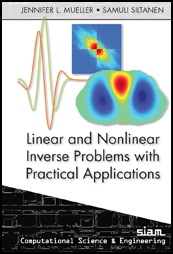Inversio-ongelmat, kevät 2013
Inversio-ongelmat, kevät 2013
Inverse problems, spring 2013
Finnish summary:
Inversio-ongelmien tutkimus on sekä puhtaan että sovelletun matematiikan aktiivinen
osa-alue, joka on Matematiikan ja tilastotieteen laitoksella edustettuna kolmen professorin,
lukuisten tutkijoiden ja jatko-opiskelijoiden sekä Suomen Akatemian huippuyksikön voimin.
Alan tutkimuksessa tavoitteena on saada tuntemattomasta kohteesta tietoa epäsuorien mittausten avulla.
Inversio-ongelmilla on sovelluksia monilla eri tieteen ja tekniikan aloilla.
Näitä ovat mm. signaalinkäsittely, rakenteita tuhoamaton testaus, fysiikka ja astrofysiikka,
muodon optimointi, lääketieteellinen kuvantaminen ja potilaan elintoimintojen seuraaminen,
solubiologia, geofysikaalinen kuvantaminen sekä optiohinnottelu osakemarkkinoilla.
Esimerkkejä inversio-ongelmista:
-Epätarkan valokuvan terävöittäminen
-Kolmiulotteinen röntgentomografia
-Maan rakenteiden kuvantaminen maanjäristysaaltojen kulkuaikojen avulla
-Halkeamien etsiminen rakenteista
-Öljyn ja mineraalien etsintä
-Saasteiden maanalaisen leviämisen havainnointi
-Asteroidien muodon selvittäminen kirkkauden muutosten avulla
Yhteistä kaikille näille ongelmille on niiden herkkyys
mittausvirheille sekä se, että tutkittavasta kohteesta saadaan
vain epäsuoria ja kohinaisia mittauksia.
Keväällä järjestetään laaja inversio-ongelmien kurssi, jonka
voi sisällyttää sekä yleisen että sovelletun matematiikan syventäviin opintoihin.
Kurssin luennot koostuvat kahdesta osasta:
-Analyyttiset inversio-ongelmat (prof. Matti Lassas)
-Laskennalliset inversio-ongelmat (prof. Samuli Siltanen).
Luentojen laajuus on 5+5=10 op.
Luentojen lisäksi kurssi sisältää aiempaa "Matematiikan sovellusprojektit"-kurssia
vastaavan projektityön. Tämä tehdään ohjattuna parityönä ja sen laajuus on 5 op.
Yhteensä kurssin laajuus on siis 15 op.
English summary
Inverse problems research is an active area of both pure and applied mathematics.
At the Department of Mathematics and Statistics the field is represented by three professors,
several researchers and graduate students and a Centre of Excellence of Academy of Finland.
Inverse problems are about interpreting indirect measurements, and they have
applications to many areas of science and technology. Examples include signal processing,
non-destructive testing, astrophysics, medical imaging and geophysical prospecting.
The lectures of the course consist of two parts:
-Analytic inverse problems (Prof. Matti Lassas)
-Computational inverse problems (Prof. Samuli Siltanen).
Together the lecture parts make up 5+5=10 credit units.
In addition to lectures the course involves a project work. It is done in teams of two and
gives 5 credit units to each student.
The course is in total 15 credit units.
Lecturers
Matti Lassas ja Samuli Siltanen
Credit units
15 op.
Type
Advanced studies (syventävä opintojakso)
Prerequisites
Recommended: basics of Fourier transform, measure theory, integration and linear algebra
(for example courses Fourier-muunnoksen perusteet, Mitta- ja integrointiteoria, Lineaarialgebra 1&2).
Experience with Matlab is helpful in the computational part of the course, but not necessary.
Tutorials for learning basics of Matlab are available for example at the following locations:
Lectures
16.1.2013 Wednesday (Matti Lassas and Samuli Siltanen) Introduction to inverse problems. Presentation slides: .
18.1.2013 Friday (Samuli Siltanen) One-dimensional convolution and naive inversion. Book sections 2.1, 3.5 and 3.6.
Matlab resources:
, , , ,
, ,
, ,
,
22.1.2013 Tuesday (Matti Lassas)
23.1.2013 Wednesday (Matti Lassas)
25.1.2013 Friday (Samuli Siltanen) Singular value decomposition (SVD) for general matrices. Least squares solutions and minimum norm solutions.
Introductory remarks on truncated SVD. Book sections 3.5, 4.1 and 4.2.
29.1.2013 Tuesday (Matti Lassas)
30.1.2013 Wednesday (Samuli Siltanen) Introduction to tomographic X-ray imaging. Book section 2.3.
Matlab files available at this page.
1.2.2013 Friday (Samuli Siltanen) SVD for X-ray tomography. Tikhonov regularization and its connection to SVD.
Generalized Tikhonov regularization. Book sections 4.4.3, 5.1 and 5.3.
5.2.2013 Tuesday (Matti Lassas)
6.2.2013 Wednesday (Matti Lassas)
8.2.2013 Friday (Samuli Siltanen) Tikhonov regularization and stacked form formulation. Book Section 5.2.
12.2.2013 Tuesday; No lectures. Please go to a computer classroom and perform the following tests.
(1) Work with the files at page http://wiki.helsinki.fi/display/mathstatHenkilokunta/1D+Deconvolution
Build a for loop to the file DC6_TikhonovD_comp.m so that you plot to the same plot 100 reconstructions from
data otherwise the same but with different noise every time (created by command randn without resetting the random number generator in between).
Repeat the experiment with a couple of different values of regularization parameter alpha.
Figure 5.6 of the book gives you an idea of what to expect.
(2) Repeat the above with tomography. Work on the page http://wiki.helsinki.fi/display/mathstatHenkilokunta/X-ray+tomography+with+matrices
and modify the file called XRMG_Tikhonov_comp.m
13.2.2013 Wednesday (Samuli Siltanen) Matrix-free solution of linear equations and applications to Tikhonov regularization. Introduction to
total variation regularization and its constrained quadratic formulation. Book Sections 5.5 and 6.
15.2.2013 Friday (Matti Lassas): Inverse transform for the Fourier transform and mapping propeties
19.2.2013 Tuesday (Matti Lassas): Connection of Fourier transform and the Radon transform, Fourier slice theorem
20.2.2013 Wednesday (Samuli Siltanen): Total variation regularization: medium and large scale computation.
22.2.2013 Friday (Samuli Siltanen):
26.2.2013 Tuesday (Matti Lassas): Proof of Fourier slice theorem, first inversion formula for the Radon transform and the adjoint Radon transform.
27.2.2013 Wednesday: no lectures.
1.3.2013 Friday (Matti Lassas): Properties of adjoint Radon transform, Fourier transform of positively homogeneous distributions
12.3.2013 Tuesday (Matti Lassas): Radon type inversion formulae.
13.3.2013 Wednesday (Samuli Siltanen): Methods for choosing the regularization parameter: Morozov discrepancy principle, L-curve method and S-curve method. Book sections 5.4 and 6.3.

10.4.2013 Wednesday (Matti Lassas): Project work topic and division into teams.
Period III: Lectures and exercises, weekly schedule can be found below.
Tuesday 10-12, Exactum hall D123,
Wednesday 12-14, Exactum hall D123,
Friday 12-14, Exactum hall B120.
Friday 10-12, Exactum hall C122 / Physicum hall D210, Exercises.
Period IV: Lectures and exercises in the beginning of the period. Project work in the end of the period.
Materials
The Computational part follows the book Linear and Nonlinear Inverse Problems and Practical Applications by J.L. Mueller and S. Siltanen (SIAM 2012).
Part I of the book will be covered.

Material for the analytical part of the course will be uploaded here:
, ,
Exercises
Fridays 10-12, Exactum hall C122 / Physicum hall D210
Friday 25.1.2013: ,
Friday 1.2.2013 (Exactum hall C122):
Friday 8.2.2013 (Physicum hall D210):
Friday 15.2.2013 No exercise!
Friday 22.2.2013 (Physicum hall D210): ,
Friday 1.3.2013 (Exactum hall C122):
Exam

Questions and instructions: .
The m-file needed in question 4: .
Register
Forgot to register? What to do?.